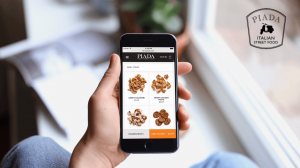The Foundation of a Profitable Restaurant: Mobile App or Website
— September 13, 2016In the current era, restaurant mobile apps and websites are essential tools for maintaining a competitive edge. The days of relying solely on phone orders are behind us. Customers increasingly prefer online ordering over traditional methods, often stating, “If they don’t have online ordering, I’m not going to call, so I’m not ordering.” This shift highlights the need for restaurant businesses to adapt and embrace digital solutions.
Restaurant website and app development has become a critical investment for business growth. With thousands of apps submitted to Apple’s App Store daily, restaurants are joining the digital movement. However, not all apps succeed. Some gain significant traction, while others fail to attract users. This disparity leads to a vital question: What makes a restaurant app or website profitable?
Essential Features for a Successful Restaurant Digital Presence
Clear and Accessible Location Information
A restaurant app or website must provide clear location details. This includes an interactive map, operating hours, and other relevant information presented in an easily accessible format. Customers rely on this information to decide where to dine or order. If the user experience in this area is subpar, potential customers will turn to competitors. For example, apps and websites with intuitive map integrations simplify navigation and enhance customer satisfaction.
Menus Tailored to Customer Needs
Including menus in a digital presence is non-negotiable. However, for multi-unit restaurants, it is crucial to offer location-specific menus. Seasonal offerings or regional specialties should be displayed clearly. A one-size-fits-all menu fails to address customer expectations. Furthermore, enabling customers to order directly from the menu streamlines the process, improving the likelihood of conversion. Menu presentation should include clear item descriptions, appealing images, and the ability to customize orders.
Seamless Online Ordering
Online ordering is the cornerstone of any successful restaurant app or website. Customers expect a smooth, intuitive experience when placing orders. Apps that lack this feature or provide a clunky interface risk losing customers. Many leading restaurant brands still lag behind in this area. Research shows that 45 of the top 100 restaurant chains do not have a native app. Even among those with apps, many fail to meet customer expectations regarding usability and design.
A well-designed online ordering system includes features like easy navigation, visually appealing layouts, and minimal steps to complete an order. These aspects reduce friction in the ordering process, encouraging repeat use.
Advanced Online Ordering Features
Basic online ordering capabilities are no longer sufficient. Customers expect additional features that enhance convenience and improve their overall experience. For instance, apps that allow users to save favorite orders simplify the reordering process. Similarly, integrating payment processing within the app lets users prepay securely, adding to their convenience.
Loyalty programs and discounts are also crucial. Customers are more likely to return to a restaurant that rewards their loyalty or offers attractive promotions. The ability to customize orders further enhances user satisfaction, allowing customers to meet dietary requirements or preferences effortlessly.
Nutrition information is another essential feature. As health-conscious choices become more prevalent, providing nutritional details builds trust and helps customers make informed decisions. Restaurants offering catering services should mention these prominently and, if possible, enable scheduling and ordering through the app.
For offices or groups, introducing a group ordering feature adds immense value. Simplifying the process for teams to place large orders collectively improves the likelihood of securing high-value orders. Another impactful feature is suggestive upselling. Encouraging customers to add items like desserts, sides, or drinks before checkout increases order value and introduces them to new menu options.
Leveraging Feedback and Building Customer Trust
Feedback mechanisms play a pivotal role in app and website success. Allowing customers to leave reviews or share their experiences demonstrates a commitment to service quality. Additionally, responding to feedback promptly helps resolve issues and builds customer trust. Reviews provide social proof, influencing potential customers to choose a restaurant over its competitors.
Offering robust customer service features within the app further enhances user satisfaction. Whether resolving complaints or answering queries, quick responses can turn dissatisfied customers into loyal patrons.
Evaluating Your Restaurant’s Digital Strategy
To create a profitable restaurant mobile app or website, it is essential to evaluate your existing digital presence critically. Many restaurants still lack a mobile app, and even among those that have one, most fall short of meeting modern standards. Assess whether your digital platform offers seamless usability, engaging features, and value-added functionalities. In a competitive market, providing an exceptional online experience directly correlates with customer retention and increased revenue.
15 Must-Have Features for a Successful Restaurant Mobile App
Developing a high-functionality app isn’t just about coding; it’s about understanding what users need and delivering on those expectations. With essential features, a mobile app becomes a key asset in maintaining customer loyalty, boosting revenue, and streamlining operations. Each feature must add real value, creating a dynamic connection between customers and the restaurant.
Online Ordering
A restaurant app’s online ordering feature is its cornerstone, bridging convenience with accessibility. It allows users to browse the menu, select dishes, and place orders with a few taps.
Simplifying the ordering process is fundamental to creating a positive user experience. Digital menus, structured for easy navigation, enable customers to quickly explore options and make decisions. This feature eliminates the errors commonly associated with traditional ordering methods, ensuring accuracy. Restaurants also benefit from higher efficiency as kitchen staff can rely on clearly communicated orders.
The advantages of online ordering extend to both customers and restaurants. Customers enjoy the flexibility of ordering from anywhere and at any time, while restaurants see increased order volumes and revenue. By analyzing order data, restaurants can identify popular dishes and adjust their offerings to align with customer preferences.
Table Reservation
An integrated table reservation feature elevates the dining experience for both customers and restaurant operators. This capability allows users to secure their spot effortlessly, ensuring a smooth arrival.
Reducing wait times is one of the most immediate benefits of table reservations. Customers value predictability, and knowing their table is ready enhances their overall satisfaction. Restaurants, in turn, manage foot traffic effectively, ensuring a steady flow of patrons without overcrowding or long delays.
The customer experience is further enhanced through personalized reservation options. Restaurants can use customer data to anticipate preferences, such as seating choices or special occasions. This level of customization fosters loyalty, making diners feel valued and appreciated.
Menu Display with Photos
Visual presentation is a key aspect of any restaurant’s appeal, and a mobile app should prioritize this through a photo-enhanced menu display. High-quality images guide users as they browse, creating a sensory connection to the dishes.
The importance of visual appeal cannot be overstated. A beautifully crafted photo can evoke cravings, influencing a customer’s decision to try a new dish or revisit an old favorite. In a mobile app, this translates to higher engagement rates and increased order values.
The impact on decision-making is equally significant. Detailed descriptions accompanied by visuals provide clarity on portion sizes, ingredients, and presentation. This transparency builds trust, ensuring customers feel confident about their choices.
Payment Integration
A smooth payment process is critical for ensuring customer satisfaction in a restaurant app. Integrating multiple payment options, such as credit cards, mobile wallets, and online banking, provides flexibility and convenience.
Offering diverse payment methods caters to a broad audience, enhancing the app’s appeal. Restaurants benefit from faster transaction processing, which reduces bottlenecks and improves overall efficiency. Security is a paramount concern, and features like encryption and tokenization ensure customer data remains safe. This reassurance builds confidence, encouraging repeat use.
Loyalty Programs
Loyalty programs are indispensable for fostering long-term customer relationships. These programs reward repeat customers with points, discounts, or exclusive offers, incentivizing continued engagement.
By implementing loyalty programs, restaurants demonstrate appreciation for their patrons. Customers who feel valued are more likely to return and recommend the establishment to others. The data collected through these programs also provides insights into customer preferences, enabling restaurants to refine their offerings and marketing strategies.
Push Notifications
Push notifications are a powerful tool for maintaining customer engagement and driving app usage. These alerts deliver timely updates directly to users’ devices, ensuring they remain informed about promotions, menu changes, or events.
Notifications keep customers connected to the restaurant, creating a sense of immediacy and relevance. They are particularly effective for promoting limited-time offers or encouraging visits during off-peak hours. Well-crafted notifications enhance the user experience, offering value without being intrusive.
Order Tracking
Order tracking enhances transparency and trust by providing customers with real-time updates on their orders. This feature is especially valuable for delivery services, as it allows users to monitor progress from preparation to arrival.
Real-time updates improve planning and reduce uncertainty, contributing to a more positive customer experience. By demonstrating reliability and efficiency, restaurants build stronger relationships with their patrons, encouraging repeat business.
In-App Chat Support
In-app chat support is essential for addressing customer inquiries promptly and effectively. This feature ensures users can resolve issues or obtain information without delays, enhancing overall satisfaction.
Instant communication is a cornerstone of modern customer service. Whether clarifying menu details or addressing dietary restrictions, quick responses prevent frustration and improve the dining experience. Restaurants that prioritize support foster loyalty and trust among their customer base.
Social Media Integration
Social media integration expands a restaurant’s visibility by encouraging users to share their experiences online. Features such as photo sharing, hashtags, and location tags amplify the restaurant’s reach, attracting new customers through organic promotion.
Encouraging social sharing turns diners into brand ambassadors. Each post or tag contributes to the restaurant’s online presence, creating buzz and driving engagement. Reacting to customer posts further strengthens connections, building a loyal community around the brand.
Customer Reviews and Ratings
A robust review system allows customers to share feedback, providing valuable insights for the restaurant. Positive reviews enhance credibility, attracting new patrons and boosting the restaurant’s reputation.
Feedback systems facilitate continuous improvement by highlighting areas that need attention. Restaurants that actively address concerns demonstrate a commitment to quality, fostering trust and loyalty.
Customizable Menu Options
Customizable menus accommodate dietary preferences, creating a more inclusive dining experience. This feature allows users to modify dishes to suit their tastes, ensuring satisfaction.
Personalization enhances customer happiness by addressing specific needs, such as allergies or dietary restrictions. Restaurants benefit from increased loyalty as customers appreciate the effort to cater to their individual preferences.
Location-Based Services
Location-based services use GPS technology to connect customers with nearby restaurants. This feature is invaluable for chains, enabling users to find the closest branch and access relevant information.
Providing directions and filtering nearby branches streamline the decision-making process, encouraging spontaneous visits. By offering location-specific promotions, restaurants can attract local customers and boost foot traffic.
Multilingual Support
Multilingual support ensures accessibility for a diverse customer base. By offering language options, restaurants can effectively communicate with patrons from various backgrounds, fostering inclusivity.
This feature enhances the app’s usability, making it a valuable tool for both local and international customers. Clear communication across languages improves satisfaction, encouraging repeat visits.
Waitlist Management
Waitlist management tools optimize seating arrangements and reduce wait times, improving the overall dining experience. Real-time updates keep customers informed, allowing them to plan their time effectively.
By streamlining operations, waitlist systems enhance efficiency and customer satisfaction. Guests appreciate the convenience, which often translates into positive reviews and increased loyalty.
User Profiles
User profiles enable personalized experiences by storing preferences, order history, and other relevant information. This feature simplifies future interactions, making the app more user-friendly.
Saving preferences allows customers to reorder favorites quickly, while personalized suggestions enhance engagement. Restaurants can use this data to refine their offerings and create targeted marketing campaigns, fostering deeper connections with their patrons.
Conclusion
Profitability in the restaurant tech space depends on delivering a comprehensive, user-friendly digital experience. Focusing on clear location information, detailed menus, seamless online ordering, and feedback mechanisms can transform your app or website into a powerful business tool. As customer expectations continue to evolve, staying ahead of digital trends is key to sustained success.
A successful restaurant mobile app combines convenience, functionality, and customer-centric features. By incorporating these 15 must-have elements, restaurants can elevate their service, enhance customer loyalty, and thrive in the competitive dining industry. Each feature contributes to a seamless and enjoyable experience, ensuring the app becomes an indispensable part of the dining journey.
Partnering with a reliable outsourcing service for app and website development can address these gaps effectively. Companies like S3Corp in Vietnam specialize in delivering tailored solutions for restaurants, combining user-centric design with advanced technological features. By leveraging outsourcing, restaurants can ensure their digital platforms meet industry standards and customer expectations.





